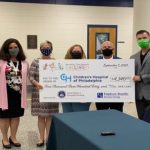It was June 11 when a teenager showed up at Children’s Hospital of Wisconsin short of breath. He had lost a lot of weight, was fatigued and couldn’t do routine activities.
A chest X-ray showed something doctors found odd: interstitial pneumonia. Unlike the more common viral or bacterial pneumonia that infects one or two of the lungs’ five lobes, interstitial pneumonia looks like a complex spider web crisscrossing the entire lung.
“It’s usually associated with bad disease,” said Michael Meyer, medical director of the Pediatric Intensive Care Unit.
Describing for the first time how they helped uncover that vaping may be behind hundreds of serious lung injuries and as many as six deaths across the country, Meyer and a team of doctors at Children’s say it was a hospital-wide effort — and specialized training in working with teens — that led to the discovery.
The doctor said it didn’t make sense for a previously healthy teen to quickly develop this kind of illness. They pulled in specialists from across the hospital: pulmonology, infectious disease, pathology, immunology and even oncology. They did a CT scan and a lung biopsy.
“We thought, ‘Do we have cancer here?’ ” Meyer said.
They launched what amounted to a broad-ranging medical investigation as doctors throughout the hospital scrambled to find a cause — and a treatment.
All tests came back negative. It was a mystery.
About two weeks later, another teen arrived. The X-ray looked similar.
And then came another. It was the July Fourth weekend.
Meyer said he clearly remembers the moment Lynn D’Andrea, the hospital’s medical director of pulmonary services, warned him they may be dealing with an outbreak of some kind.
“I was on call. Dr. D’Andrea was on pulmonology. She came out of the operating room, and she said ‘This is the third one. This is weird. There’s something else going on. We have to start figuring this out,’ ” Meyer said.
Two more patients were admitted that same weekend.
“The third, fourth and fifth teens all came within two days of each other,” D’Andrea said. They all showed “significant injury,'” she said.
“That specific injury is very rare. I had seen it probably once in 25 years, and so three in a week — it’s like, this has to be something different,” D’Andrea said. “And there was this common thread of vaping.”
Doctors at Children’s are trained to ask teens questions about their activities and lifestyles for clues into their overall health. They ask about medications, illicit drugs, smoking, vaping, drinking and sexual activity.
But sometimes there is a problem: Teenagers aren’t always truthful.
“Especially if their parents are there,” Meyer said.
So doctors began to separate the teens from their parents and drill down in their questioning.
“Sometimes the parent may be out of the room to get a cup of water, or get coffee, or go home and get some clothes, and so that’s a good opportunity to try to get the confidence of the teen and try to get them to tell everything they’ve been doing, really in their best interest,” said Dr. Louella Amos, a Children’s Hospital pulmonologist.
The patients continued to arrive, and the questioning continued. Meyer said that by July 16 doctors came to a realization: “Oh, these kids have all vaped in recent weeks.”
‘This was a public health issue’
Doctors at Children’s called the state Department of Health Services and sounded an alarm. The hospital was seeing a cluster of unusual — and, in some instances, life-threatening — cases. And the only tie they could find was that all the patients had reported recently vaping nicotine or THC or both.
“This was a public health issue. We’re seeing these healthy adolescents and teenagers with these sudden, very significant lung problems,” said Michael Gutzeit, the hospital’s chief medical officer.
Children’s Hospital doctors didn’t know it at the time, but they would be among the first to make the connection between vaping and an outbreak of severe lung injuries in teens that within weeks would spread to more than 30 states and turn up about 400 similar cases. No fatalities have occurred in Wisconsin, but six deaths have been reported in other states.
State officials praised Children’s doctors for moving so quickly.
“Their reports allowed us to confirm the outbreak and to alert local and tribal health departments and health care providers around the state,” said Jon Meiman, chief medical officer and state epidemiologist for the state Department of Health Services. “This type of early reporting is key to effective public health surveillance.”
Gov. Tony Evers said the move by Children’s helped put Wisconsin “on the national forefront of the investigation.”
“The combined efforts of Children’s Hospital of Wisconsin and the Department of Health Services have helped us get the word out to families across our state, and the nation, that vaping is a risky behavior,” Evers said in a statement.



